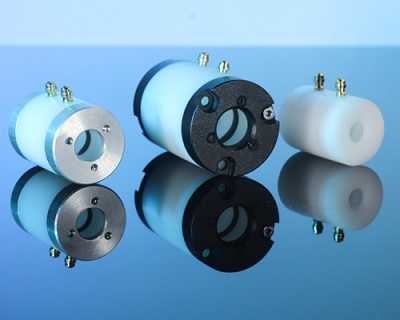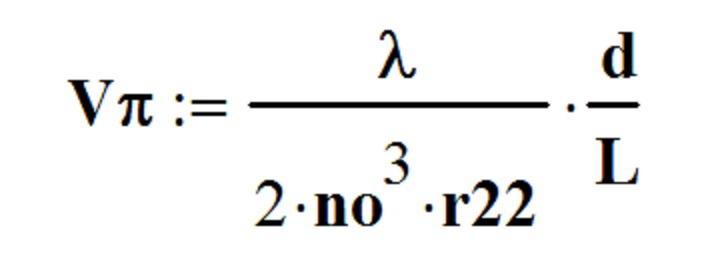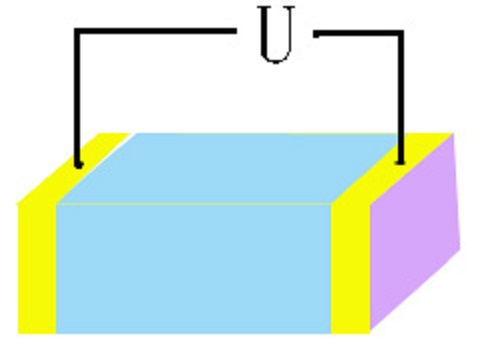Pockels cells
1.Intro:
Pockels Cells are important electro-optic device which exploit the pockels effect. Applying a constant or varying voltage (electric field) on Electro-Optic Crystals can cause the crystal birefringence to change linearly. A Pockels cell applied with a constant voltage is actually equivalent to a voltage-controlled wave plate. When a varying voltage is applied, the Pockels cell can change the phase delay of the crystal. The Pockels cell is the basic component of various optical devices, such as Q-switch and electro-optic modulator of the laser. They are vital components for e.g. Q-switching lasers.Electro-optic Pockels cells are used in applications that require fast switching of the polarization direction of a beam of light. These uses include Q-switching of laser cavities, coupling light into and out from regenerative amplifiers, and, when used in conjunction with a pair of polarizers, light intensity modulation.

Fig.1 Pockels cells of Shalom EO
Guides:
- Pockels effect
- Half-Wave Voltage
- Longitudinal devices and transverse devices
- Working principles of pockels cells
2.Pockels effect:
An electro-optical effect. Certain crystals will produce an additional birefringence under the action of an electric field. The change of refractive indices are linearly proportional to the magnitude of the applied electric field. In 1893, the German physicist F. Pockels first studied this linear electro-optic effect, which gave it its name.
However, this effect only occurs in crystals that lack inversion symmetry, such as lithium niobate (LiNbO3), lithium tantalate (LiTaO3), barium borate (BBO), and gallium arsenide (GaAs), etc. Or exist in other non-centrosymmetric media, such as electric field polarized polymers and glass.
3.Half-Wave Voltage
An important property of a Pockels cell is the half-wave voltage Uπ(also called Uλ/2 or Vλ/2). This is the voltage required for inducing a phase change of π, equivalent to a half an optical wavelength. In an amplitude modulator, the applied voltage has to be changed by that value in order to go from the operation point with minimum transmission to that with maximum transmission.
To be give a more direct demonstration, here is an equation for the half voltage of beta BBO crystals:

Where λ=optical wavelength
d=electrode spacing
L=optical path length
r22=electro-optic coefficients
no=ordinary indices of refraction
Typical Pockels cell have half-wave voltages of hundreds or even thousands of volts, so that a high-voltage amplifier is required to support large modulation depths. Relatively small half-wave voltages are possible for crystal materials that are highly nonlinear(e.g.)LiNbO3, and for integrated optical modulators with a small electrode separation, the problem is that such devices have relative weak power handling capabilities.
4.Longitudinal devices and transverse devices
To be brief, Longitidinal devices are devices designed to have identical directions between light propagation and the electric field.
Transverse devices have the direction of light propagation perpendicular to the direction of the electric field.
|
|
Longitudinal EO Modulation |
Transverse EO Modulation |
The half wave voltage of longitudinal modulators are independent of the dimensions of the crystals. While the half wave voltage of transverse modulators are inversely proportional to length of the optical path over the thickness of the crystal (electrode spacing ).
We could deduce from the statements above the features of longitudinal and transverse devices:
Longitudinal device:
- The electrode needs to be installed on the light-transmitting surfaceIn order not to affect the light propagation, the electrode needs to be made into a special shape.
- The amount of phase delay has nothing to do with the length of the crystal so half-wave voltage cannot be reduced by increasing the length of the crystal.
Transverse device:
- It can increase the length of the material and reduce the thickness to reduce the mottle voltage.
- The disadvantage is that the phase shift is caused by natural birefringence and is sensitive to temperature.
5.Working principles of pockels cells
Here is a brief model of how a electro-optic Q switch work. We assume that the crystal has no birefringence without an applied electric field.
- Place a polarizer and Pockels cell between the active medium and the total reflection mirror. The polarizer is aligned such that we obtain 100 % transmission (disregarding some parasitic losses) without an applied voltage. .
- Apply an appropriate wave voltage to the Pockels cell, which makes the polarization plane of the transmitted light Rotate 45°
- The reflector reflects the light and passes through the Pockels cell again, the polarization plane rotates 45° again. At this time, the light cannot pass through the polarizer, so the Q value in the cavity is very low.
- Cut off the voltage at a high speed, the Q value in the cavity suddenly rises to produce a giant pulse laser output.
So as the voltages vary, the transmission switches from 0% to 100%, pulses are generated.The electro-optical switch must be synchronized with the pump. The electro-optical switch has a high speed and can be accurately controlled at the time of switching. However, the switching performance is dependent upon the variety and quality of the electro-optical crystal.Typically, one would vary the voltage between zero and the half-wave voltage, although in principle one may also vary it between −Uπ / 2 and +Uπ / 2.
Tags: Pockels cells



